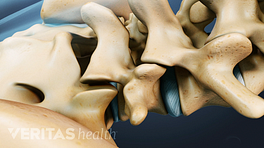Motion preservation procedures for the spine is a newer set of operations that have been devised to correct some of the problems we've had with previous spine surgeries. Often in an attempt to treat pain and dysfunction we do spinal fusions and that involves stiffening of the spine and taking -- helping with pain in a fairly effective way, but with the consequence of the stiffening causing additional problems with posture, with ability to function in some respects. Many times in an attempt to treat pain now we can find the area of the pain, whether it's coming from the discs or the joints, and try to treat that in a way that allows the joint and the disc to continue to function and move and that whole area of motion preservation surgery has evolved in the spine and continues to evolve. If the disc is the source of a problem, then rather than fusing that disc, we can sometimes now use artificial discs, either made of metal and plastic or metal and metal, to be able to articulate and continue to move in the same way that an artificial hip or an artificial knee is able to move and people are able to have relief of their pain but continue to function. If the problem relates to pressure on the nerves, rather than the disc itself, we can sometimes help stabilize the motion without taking it away, using special flexible rods in the back of the spine or devices that sit between the processes of the spine called 'interspinous process spacers' with the same goal of helping relieve pain, but maintaining some element of motion to help patients function better and still treat their pain.
In This Article:
- Motion Preservation Procedures Video






